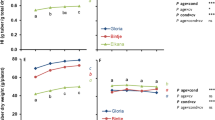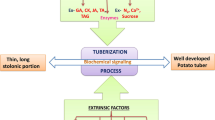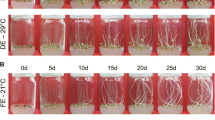Summary
A number of previously selected hydroxyproline (hyp) resistant cell lines of a diploid potato (Solanum tuberosum L., clone H2578, 2n=2x=24) could be regenerated into plants which were further analysed. Hyp resistance, although lower than in the originally selected calli, was still present in regenerated shoots and in callus initiated from these shoots and it was not lost upon (mini)tuber propagation. Regenerated shoots showed a wide range of phenotypic variation. The chromosome number, analysed in 4 clones, appeared to be hypotetraploid (44 or 45). Tuber-propagated regenerants generally showed increased frost tolerance both at the plant and the cell level. In leaves this seemed to be associated with increased levels of both proline and total amino acid content. However, in callus only the total amino acid content but not proline was still elevated. In the wild type the frost tolerance of the tubers appeared to be lower than that of the leaves. Between tubers of wild type and the hyp resistant regenerants no differences in frost tolerance were found, although proline and total amino acid content tended to be higher in tubers from the regenerants.
Similar content being viewed by others
References
Aspinall, B. & L. G. Paleg, 1981. Proline accumulation: physiological aspects. In: L. G. Paleg & D. Aspinall (Eds), The physiology and biochemistry of drought resistance in plants pp. 206–241. Academic Press, Sydney. 0–12–544380–3.
Bates, L. S., R. P. Waldren & I. D. Teare, 1973. Rapid determination of free proline for water-stress studies. Plant Soil 39: 205–207.
Behnke, M., 1975. Regeneration in Gewebekulturen einige dihaploiden Solanum tuberosum Klone. Z. Pflanzenzüchtg 75: 262–265.
Bieleski, R. L. & N. A. Turner, 1966. Separation and estimation of amino acids in crude extracts by thin layer electrophoresis and chromatography. Anal. Biochem. 17: 278–293.
Bokelmann, G. S. & S. Roest, 1983. Plant regeneration from protoplasts of potato (Solanum tuberosum L. cv. Bintje). Z. Pflanzenphysiol. 109: 259–265.
Cella, R. & P. Iadarola, 1983. Characterization of carrot cell lines resistant to 5-methyltryptophane obtained by irradiating suspension cultures with UV-light. Plant Sci. Lett. 29: 327–337.
Cella, R., B. Parissi & E. Nielson, 1982. Characterization of a carrot cell line resistant to azetidine-2-carboxylic acid. Plant Sci. Lett. 24: 125–135.
Chaleff, R. S., 1981. Genetics of higher plants. Application of cell culture, pp. 41–95 Cambridge University Press, New York. 0–521–22731–3.
D'Amato, F., 1986. Cytogenetics of plant cell and tissue cultures and their regenerates. CRC Critical Rev. Plant Sci. 3: 73–112.
Daub, M. E., 1984. A cell culture approach for the development of desease resistance: studies on the phytotoxin cercosporin. HortScience 19: 18–23.
Dix, P. J., 1977. Chilling resistance is not transmitted sexually in plants regenerated from Nicotiana sylvestris cell lines. Z. Pflanzenphysiol. 84: 223–226.
Dix, P. J., U. A. McLysaght & R. S. Pearce, 1984. The potential of cell cultures for the production of salt-tolerant cultivars. In: W. Lange, A. C. Zeven & N. G. Hogenboom (Eds), Proceedings 10th Congress of Eucarpia, pp. 219–223. Pudoc, Wageningen. 90–220–0856–8.
Estrada, N. R., 1982. Breeding wild and primitive potato species to obtain frost resistant cultivated varieties. P. H. Li & A. Sakai (Eds), Plant Cold hardiness and freezing stress: Mechanisms and crop implications, Vol. II, pp. 615–634. Ac. Press, New York. 0–12–447602–3.
Firbas, H. & H. Ross, 1962. Züchtung auf Frostresistenz bei der Kartoffel. II. Über die Frostresistenz der K nolle und ihre Beziehung zur Frostresistenz des Laubes. Z. Pflanzenzüchtung 47: 51–66.
Harten, A. M. van, H. Bouter & C. Broertjes, 1981. In vitro adventitious bud techniques for vegetative propagation and mutation breeding of potato (Solanum tuberosum). Euphytica 30: 1–8.
Howard, H. W., 1978. The production of new varieties. In P. M. Harris (Ed.), The potato crop. The scientific basis for improvement, pp. 607–646. Chapman & Hall, London. 0–412–12830–6.
Huttema, H., J. Woltjes, L. Vigh & P. Hasselt, 1982. Drought induced frost resistance in wheat correlates with changes in phospholipids. In J. F. G. M. Wintermans & P. J. C. Kuiper (Eds), Biochemistry and metabolism of plant lipids. pp. 433–436. Elsevier Biomedical Press, Amsterdam, 0–444–80457–9.
Hussey, G. & N. J. Stacey, 1984. Factors affecting the formation of in vitro tubers of potato (S. tuberosum L.). Ann. of Bot. 53: 565–578.
Jacobsen, E., 1981. Polyploidization in leaf callus tissue and in regenerated plants of a diploid potato. Plant Tissue Organ Cult 1: 77–84.
Jacobsen, E., M. J. Temphlaar & E. W. Bijmolt, 1983. Ploidy levels of leaf callus and regenerated plants of Solanum tuberosum determined by cytophometric measurements of protoplasts. Theor. Appl. Genet. 65: 113–118.
Jacobsen, E., R. G. F. Visser & J. Wijbrandi, 1985. Phenylalanine and tyrosine accumulating cell lines of a dihaploid potato selected by resistance to 5-methyltryptophan. Plant Cell Rep. 4: 151–154.
Jacobsen, E., 1986a. Isolation, characterization and regeneration of a S-(2-aminoethyl) cysteine resistant cell line of dihaploid potato. J. Plant Physiol. 123: 307–315.
Jacobsen, E., 1986b. Genetic diversity in protoplast- and cell derived plants of potato (Solanum tuberosum L.). In: Y. P. S. Bajaj (Ed), Biotechnology of plant improvement, Vol. III. Potato. Springer Verlag, Berlin. In press.
Karp, A. & S. W. J. Bright, 1985. On the causes and origins of somaclonal variation. Oxford Surveys of Plant Mol. Cell Biol. 2: 199–234.
Maliga, P., 1984. Isolation and characterization of mutants in plant cell culture. Annu. Rev. Plant Physiol. 35: 519–542.
Murashige, T. & F. Skoog, 1962. A revised medium for rapid growth and bioassays with tobacco tissue cultures. Physiol. Plant. 15: 473–497.
Negrutiu, I., M. Jacobs & A. Cattoir-Reynaerts, 1984. Progress in cellular engineering of plants: biochemical assessment of selectable markers from cultured cells. Plant Mol. Biol. 3: 289–302.
Petolino, J. F. & G. B. Collins, 1984. Cellular approaches to environmental stress resistance. In; Applicatios of genetic engineering to crop improvement, pp. 341–390. Martinus Nijhoff/Dr. W. Junk Publ., Dordrecht.
Pijnacker, L. P. & M. A. Ferwerda, 1984. Giemsa C-banding of potato chromosomes. -Can. J. Genet. Cytol. 26: 415–419.
Pijnacker, L. P., J. H. M. Hermelink & M. A. Ferwerda, 1986. Variability of DNA content and karyotype in cell cultures of an interdihaploid Solanum tuberosum. Plant Cell Rep. 5: 43–46.
Roest, S. & G. S. Bokelmann, 1976. Vegetative propagation of Solanum tuberosum L. in vitro. Potato Res. 19: 173–178.
Rudorf, W., 1958. Frostresistenz. In: H. Kappert & W. Rudorf (Eds.), Handbuch der Pflanzenzüchtung, Vol. 3, 2nd edit. pp. 131–138 Verlag P. Parey, Berlin.
Sree Ramulu, K., P. Dijkhuis, Ch. H. Hanisch ten Kate & B. de Groot, 1985. Patterns of DNA and chromosome variation during in vitro growth in various genotypes of potato. Plant Sci. 41: 69–78.
Stewart, G. R. & F. Lahrer, 1980. Accumulation of amino acids and related compounds in relation to environmental stress. In: B. J. Miflin (Ed.), The biochemistry of plants, a comprehensive treatise, Vol. 5: Amino acids and derivates, pp. 609–635. Academic Press, New York. 0–12–675405–5.
Sukumaran, N. P. & C. J. Weiser, 1972. An excised leaflet test for evaluating potato frost tolerance. HortScience 7: 467–468.
Swaaij, A. C. van, E. Jacobsen & W. J. Feenstra, 1985. Effect of cold hardening, wilting and exogenously applied proline on leaf proline content and frost tolerance of several genotypes of Solanum. Physiol. Plant. 64: 230–236.
Swaaij, A. C. van, J. A. K. W. Kiel, E. Jacobsen & W. J. Feenstra, 1986a. Selection, characterisation and regeneration of hydroxyproline resistant cell lines of Solanum tuberosum: tolerance to NaCl and freezing stress. Physiol. Plantarum 68: 359–366.
Swaaij, A. C. van, K. Talsma, H. Krijgsheld, E. Jacobsen & W. J. Feenstra, 1986b. Frost tolerance in cell cultures of potato. Physiol. Plantarum. In press.
Templeton-Somers, K. M., W. R. Sharp & R. M. Pfister, 1981. Selection of cold resistant cell lines of carrot. Z. Pflanzenphysiol. 103: 139–148.
Author information
Authors and Affiliations
Rights and permissions
About this article
Cite this article
Van Swaaij, A.C., Nijdam, H., Jacobsen, E. et al. Increased frost tolerance and amino acid content in leaves, tubers and leaf callus of regenerated hydroxyproline resistant potato clones. Euphytica 36, 369–380 (1987). https://doi.org/10.1007/BF00041480
Received:
Issue Date:
DOI: https://doi.org/10.1007/BF00041480




